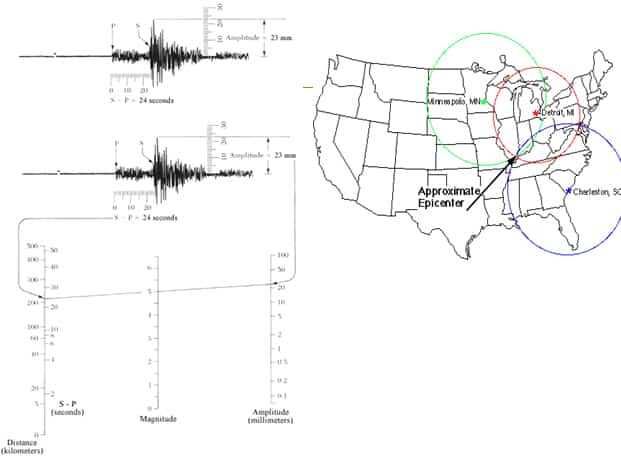- Are caused by the shaking or trembling caused by the sudden release of energy
- Usually associated with faulting or breaking of rocks – cracking of the plates also called faults.
- Continuing adjustment of position results in aftershocks
Unstable Earth
- The Earth’s crust is subjected to huge forces
- Very large forces can fracture the rock
- This can be seen as fault lines in the rock layers
- The Focus and Epicenter of an Earthquake
- The point within Earth where faulting or cracking of the rock begins is the focus
- The point directly above the focus on the surface is the epicenter
Where Do Earthquakes Occur and How Often?
- ~80% of all earthquakes occur in the Pacific rim belt
- most of these result from converging plate activity
- ~15% occur in the Mediterranean-Asiatic belt
- remaining 5% occur in the interiors of plates and on spreading ridge centers
- more than 150,000 quakes strong enough to be felt are recorded each year
Causes of Earthquakes
- The cause of most major earthquakes is the strain that builds up along faults at or near boundaries between lithospheric plates.
- A fault is a break in the lithosphere along which movement has occurred.
- The depth at which an earthquake originates depends upon the type of plate boundary involved
- Causes of Earthquakes
- At divergent boundaries such as the M.O.R, earthquakes tend to occur within the first 30 km of the surface
- This is the case for transform boundaries as well
- At subduction zones, however, as one plate plunges into the mantle, the focus of the earthquakes can be as far down as 700km below the surface
Body Waves
- The energy released in an earthquake travels in waves.
- Waves that travel from the focus of an earthquake through Earth are called body waves

- Every earthquake produces two different types of body waves – P waves, S waves
- P waves – compressional waves also known as the Primary wave
- P waves squeeze and stretch rock material as they pass through Earth – can travel through everything – solid rock, magma, ocean, and even air
- The second group of waves – the S waves or secondary waves – cause the particles of rock material to move at right angles to the direction in which the waves are travelling.
- S waves can only travel through solid material but not through liquids or gases
- The velocity of P and S waves depends on the type and density of the material which they travel through
- Velocity is greater through materials that are rigid and dense
- Through all types of solid material, S waves travel at a little more than half of the speed of P waves
Surface Waves
- These are the waves that travel along the Earth’s surface
- Surface waves are produced when P and S waves reach the surface
- The two types of surface waves are Love waves and Rayleigh waves
- Love waves cause particles to move from side to side, Rayleigh waves travel more slowly and cause particles to move in elliptical patterns.
- Surface waves cause considerable damage to structures
How do we measure Earthquakes?
- We measure earthquakes using a seismograph – it measures the seismic waves that are sent out by the earthquake
- Earthquakes are measured on the Richter Scale
- 6.1 earthquake on richter scale is 100 times more powerful than a 5.1 event
Locating and Measuring Earthquakes
- Seismographs – b/c earthquakes produce different types of wave motions, there are different types of seismographs to measure them
- In a seismograph, a heavy weight is attached to the base anchored in bedrock – this allows the weight to stay still even in an earthquake
- A record sheet called a seismogram is placed on the drum which records the wavy lines of an earthquake
Interpreting a Seismogram
- P waves are the first waves to be recorded by a Seismograph, followed by the S waves and then surface waves.
- The further the Seismograph is from the source of the earthquakes, the longer the lag time between the P waves and S waves
- A travel – time graph shows the relationship b/w P and S wave arrival times and the distance from an earthquakes epicenter
Locating the Epicenter
- Since a Seismograph tells scientist the distance to an earthquake, it does not tell them the exact location of the earthquake
- To determine the exact location of an earthquake, we need to know the distances from at least three different stations in order to plot an epicenters location
- After getting data from three stations, draw a circle from the station, the point at which all three circles meet is the epicenter
Measuring an Earthquakes Magnitude
- The magnitude of an earthquake can also be measured using the seismogram.
- The scale of earthquake magnitude was introduced by Charles F Richter in 1935
- So each increase in a whole number in the Richter magnitude is 31 times more powerful than the last number
- ie – magnitude 7 is 31 more powerful than a magnitude 6


